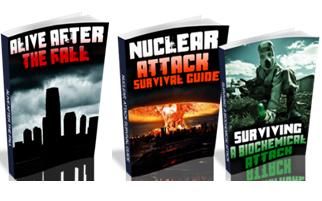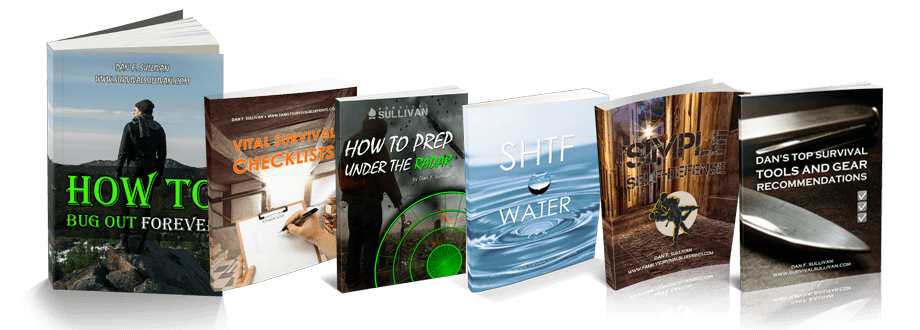Have you thought about how you’ll get around in the event that hopping in your car and driving someplace isn’t an option? Transportation and mobility are extremely important factors in preparedness.
Mobility can vary significantly during SHTF versus normal times. But it remains equally essential to logistics and safety. We must stay mobile to restock supplies, search for help (or help others), communicate, evade threats, etc. If things haven’t gone full Mad Max, you may need an alternative mode of transportation.
So what is the ultimate SHTF vehicle? You can find all sorts of fancy bug-out vehicles out there, but if you’re on a budget this may not be an option. Perhaps it’s time to consider the humble bicycle.

Mobility (or lack thereof) depends a lot on the scenario
War, martial law, a natural disaster: each situation calls for a strategy, considering speed, distance, mode of transportation and load/cargo capacity, and also the status of the infrastructure. Either way, we must be able to move around with the maximum safety possible. When other rules change, the rules of mobility follow suit.
Being mobile has just one meaning, but various reasons and different forms. Sometimes we must go fast. Other times going fast means drawing unwanted attention or risking an accident. There’s also range and cargo capacity. There’s stuff to be done nearby, and there’s stuff to be done far away. Sometimes we must move around slowly and stealthily.
How SHTF affects mobility
SHTF can impact mobility in many ways. Since the outbreak of COVID-19 and all the craziness that came with it, we’ve seen how fast things can change.
During SHTF, there is undoubtedly social chaos going on. And it is likely gridlocks, blockades, debris, and various obstacles will affect, maybe even impair, traffic and public transportation. Floods, earthquakes, and similar can wreak havoc on infrastructure too. There is also a risk of breaking curfew, experiencing conflict, and being targeted by authorities or outlaws. Crime waves are a concern too.
We must think this through and come out with flexible and reliable solutions. Those are usually the most simple ones.
Play out in advance what scenarios are likely to occur during SHTF
Fuel is hard to stock and can’t be recycled. It takes space, it smells, emits fumes, draws attention. It demands intensive and specialized labor and equipment to produce. Once it’s over and there’s a shortage, it’s tough to improvise or substitute., although there are a few possibilities. Even if roads and vehicles are still around during a disaster or SHTF (a flood, earthquake, whatever), access to fuel may be challenging at the minimum.
I know some people who stock fuel for SHTF. For heating or cooking, it can be OK. Fuel is essential. In rural areas and farms, stocking fuel is the norm. But it can be dangerous and not very practical for city dwellers. Most people in the city have limited space and other restrictions, some of them legal.
Stocked fuel may not last much during a prolonged shortage or collapse either. Late last year, an entire state in Brazil went grid-down for more than a month due to a power transformer failure. Even places like hospitals that are always ready for these situations faced trouble after just a week. Fuel got used up, confiscated, looted, sold in the black market. That’s how things run (or should I say, don’t run) in a real SHTF.
Walking is the most basic, simple answer.
Walking is time-proven. It is perhaps the best way to move around when things turn sour. It’s basic, slow, un-fancy, and free. (Maybe that’s why it doesn’t get much attention or promotion.) It is safer than running and gentler on the body.
During crazy periods we must do things slow and deliberately. Most preppers say that because that’s what works.
Bicycles top the list as the most efficient and versatile machine created
But sometimes, we need speed or more cargo capacity without giving up on being discreet. I’ll make a case for two-wheels here: as a way to cover more ground (urban or rural) quickly without drawing much attention, bicycles are perhaps the best vehicle to use during SHTF. It’s a simple, legit, and inconspicuous force multiplier.
This concept is rather obvious for the prepper: efficiency provides an even higher yield during a disaster. Everything becomes more difficult, and we have to care for a lot more stuff while spending as little energy as possible. Any tool or piece of gear that can leverage our capacities is highly welcome.
A person on a bike can travel more than 2.000 miles on the equivalent energy of a gallon of fuel. Twice as fast as someone running, without the impact, and for a lot longer before exhaustion. The bicycle can hold ten times (or more) its weight, and the rider can easily push or carry it over obstacles if necessary. We can ride bicycles even in the middle of absolute chaos. They’ve been successfully used during wars by civilians and the military.
Here are just a few pros of bicycles:
- We can ride bikes on and off the road
- We can ride along with or against the flow
- We can ride it outdoors and indoors (day and night, rain or shine)
- Bikes can be taken upstairs or put into elevators
- We can take bikes on trains and buses and in cars
- Bikes are easily camouflaged and concealed
- EMPs or grid-downs do not impair bicycles (unless they’re electrically assisted – I’ll get there)
- Bikes can move over poorly conditioned surfaces, such as streets destroyed or covered in debris
- Bicycles are relatively inexpensive (having one robbed, damaged, or left behind won’t break anyone financially)
- Bikes can be fixed or replaced easily without too much cost
- Bicycles are easier and cheaper to maintain than cars
- Repairs can be done on-the-go, or conveniently at home
- Spare parts are pretty much standard and inexpensive (though not always, I admit)
- Spare parts may be scavenged from other bikes
- And, you can insure your bicycle (if that’s a thing after SHTF)
That covers a lot, don’t you agree?
But, that’s not all, the list of advantages continues
Bicycles are silent, a lot more silent than a motorcycle or a car. That alone can provide a huge tactical advantage in some situations.
They can also carry some load, though weight becomes an issue and presents a limitation at a point. It is possible to use a cargo trailer to bring extra gear, more oversized packages, or other people. (Such as elderly, children, disabled, or injured.) Sure, that means less agility and speed, but speed isn’t always a good thing during SHTF. Consider the pros and cons of this according to your situation.
One can escape riots, protests, and dangerous situations swiftly on a bicycle. A bike is easily used to go search for someone or supplies and to get or take help. We could evade town and bug out definitely on a bike. Bicycles for personal protection? Absolutely! A bike can be used as a barrier when put between you and other people (or animals). The police have been using bikes as barriers in some countries to control protests and diverge groups in stadiums and other places with large concentrations.
I have not begun to reveal all the physical and psychological benefits of riding bicycles.
Best practices for bike riders, skilled and not so skilled
If you already ride, you probably possess the skills to build some fitness on top and keep going. Instead of walking, driving, or taking transportation, you can use your bike as training. I ride 4 to 6 times a week, taking my training bag (added of some weight, so I get used to the extra load) once or twice a month for my survival training.
If you’re new to bicycles and would like to start, it’s better to get professional guidance. Think it through and adapt accordingly, paying attention to safety and health. Riding a bicycle makes us move four or five times faster than walking. Sometimes even more. That means we must keep our attention and focus on the road, cars, people, transit, and everything that’s going on around us.
Walking also builds fitness, and we can focus on strategy, routes, analysis, and food or water acquisition during training. If you add in cycling, work on other aspects: reflexes, long-range vision, obstacle anticipation, and avoidance, bicycle skills, cardio.
There are many types of bicycles to choose from
I have ridden bikes my entire life, on and off the road, and even competing locally for a few years. I love all that. But for SHTF, my option would be either a mountain bike or hybrid.
Fat-tired bikes are more rugged, thus apt for all kinds of pavement. Unlike their road/racing, skinny brethren, which are better suited for conserved, smooth tarmac. MTBs also offer a more upright position and nimble, agile handling. That can be a blessing for zig-zagging, jumping curbs, and for more comfort and versatility in general, especially on bumpy and mount-dismount rides. Off-road style shoes and pedals are better suited for walking and more versatile for varied and challenging terrain.
Hybrids, also called “city bikes,” can be a good option too. They are more rugged than a road bike yet not as bulky as an off-road bike. The frames usually have rack and fender anchoring, useful for installing a rack and transport cargo, pulling a trailer, or other wheeled concoction. The wheels are big (700C), but tires are wider, stronger and grippier, than road bikes.
Another option is an electrically assisted bike
Electrically assisted bikes make appearances in SHTF novels, as in the classic Wolf And Iron by Gordon R. Dickson, where the main character, “JeeBee” Walther, starts his journey after SHTF (an economic collapse) with a solar-rechargeable, prototypical e-bike.
E-bikes can be high-speed and carry more load. You can save a lot of your energy by using a motorized bike as well, and that’s always something to consider during SHTF. They’re also silent, reliable, long-lasting, and demand little maintenance. Although a bit more than the conventional human-powered bicycle. Still, it brings many of the advantages of a motorcycle without the need for fuel, license plates, and other complexities such as weight and noise.
The downsides are long charging times and relatively limited autonomy. If an e-bike goes empty, pedaling is still possible, but the weight makes it too damn hard. I’m also not aware of any current e-bike that can be charged by smaller, compact solar panels. However, more powerful systems can be used if outlets go dead. They usually demand a dedicated cable or transformer for charging.
Lastly, if you believe an EMP or CME could happen as SHTF, be aware this would affect functionality like any other electrical appliance. Still, given the upsides, I wouldn’t be surprised if many chose to use an electric bike during STHF.
Other things to consider in advance
If using a bike or e-bike is in your SHTF plans, invest in quality but skip the flashy, complicated stuff. Go basic and discreet. It is also important to acquire tools (pumps, multi-tool, chain oil, mini tools, tire levers, etc.), spares (tires, chains, brake pads, air tubes), and equipment (decent lights and a good locker, also fenders and racks which add versatility). Look for the most common parts that break or need replacement.
Opt for tubeless wheels with suitable and strong tires filled with sealant fluid instead of tubes. Don’t forget to have extra sealant and also tubeless flat fixing kits. Both are extremely easy and simple to use, and cheap too.
Learn bike maintenance beforehand (at the very least the basics)
You can download or print a guide or how-to and keep it stored. You will find instructions like lubing and cleaning the transmission, changing tires, fixing flats, broken chains, wheel removals, and position adjustments in these guides. E-bikes are sturdy, and general maintenance is similar to conventional bikes, like cleaning and lubing. But the electrical system (batteries, circuits, and controls) demands specific knowledge and tools.

Get the bike fitted for you and keep it revised and always in good condition. A bike fit is essential to prevent injuries and low performance. It can be done with a specialist or learned on the internet. There are countless videos, articles, and tutorials everywhere about these and any other bike-related topics. Of course, as always, the best way to do all that is by actually riding it consistently. So keep riding.
Conclusion
If the two-wheeled route seems overly complicated, there’s always walking, or even running, as options. You can’t go wrong with that no matter the situation.
What about 4×4 ATVs, motorcycles, bug-out vehicles, and similar vehicles? They are more complicated, costly, and demand fuel, but some preppers swear by it. Depending on the context, these and other vehicles can be used and be a great advantage.
I guess that depends a lot on the strategies and plans one has. But life and reality have this weird habit of not caring for our plans. Meaning, there’s no way to tell what will happen and what will and won’t work. That’s why covering the basics is usually a good idea. Then you can put other strategies in place and have more options.
Do you have a way to get and stay mobile during SHTF?
Do you have a bicycle or many? Do you have other mobility suggestions or questions?
source : Fabian Ommar



